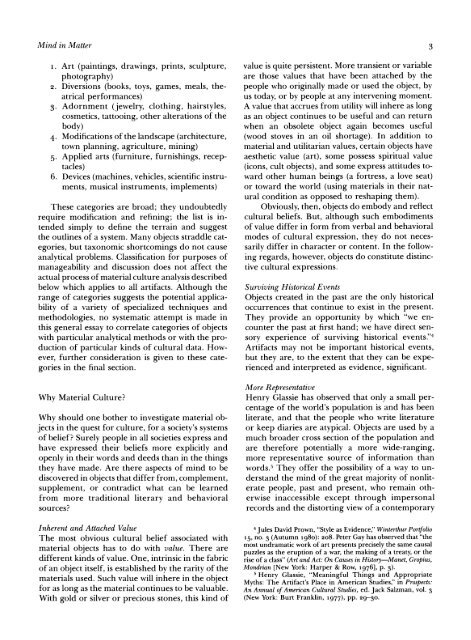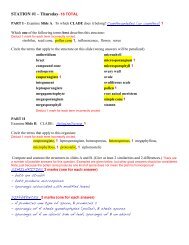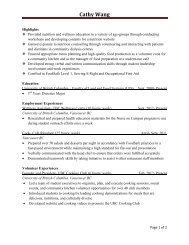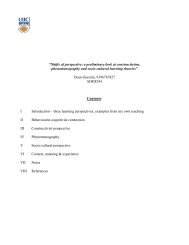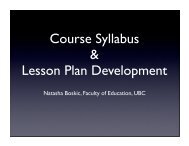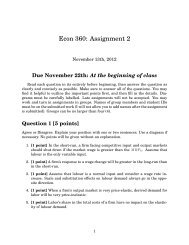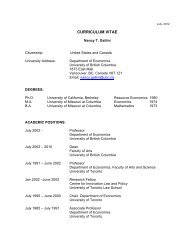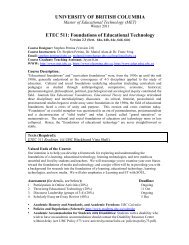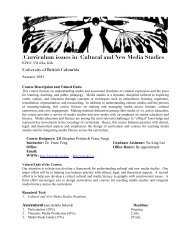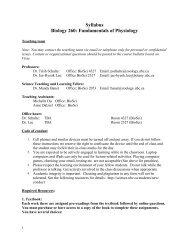Mind in Matter: An Introduction to Material Culture ... - UBC Blogs
Mind in Matter: An Introduction to Material Culture ... - UBC Blogs
Mind in Matter: An Introduction to Material Culture ... - UBC Blogs
Create successful ePaper yourself
Turn your PDF publications into a flip-book with our unique Google optimized e-Paper software.
<strong>M<strong>in</strong>d</strong> <strong>in</strong> <strong>Matter</strong>1. Art (pa<strong>in</strong>t<strong>in</strong>gs, draw<strong>in</strong>gs, pr<strong>in</strong>ts, sculpture,pho<strong>to</strong>graphy)2. Diversions (books, <strong>to</strong>ys, games, meals, theatricalperformances)3. Adornment (jewelry, cloth<strong>in</strong>g, hairstyles,cosmetics, tat<strong>to</strong>o<strong>in</strong>g, other alterations of thebody)4. Modifications of the landscape (architecture,<strong>to</strong>wn plann<strong>in</strong>g, agriculture, m<strong>in</strong><strong>in</strong>g)5. Applied arts (furniture, furnish<strong>in</strong>gs, receptacles)6. Devices (mach<strong>in</strong>es, vehicles, scientific <strong>in</strong>struments,musical <strong>in</strong>struments, implements)These categories are broad; they undoubtedlyrequire modification and ref<strong>in</strong><strong>in</strong>g; the list is <strong>in</strong>tendedsimply <strong>to</strong> def<strong>in</strong>e the terra<strong>in</strong> and suggestthe outl<strong>in</strong>es of a system. Many objects straddle categories,but taxonomic shortcom<strong>in</strong>gs do not causeanalytical problems. Classification for purposes ofmanageability and discussion does not affect theactual process of material culture analysis describedbelow which applies <strong>to</strong> all artifacts. Although therange of categories suggests the potential applicabilityof a variety of specialized techniques andmethodologies, no systematic attempt is made <strong>in</strong>this general essay <strong>to</strong> correlate categories of objectswith particular analytical methods or with the productionof particular k<strong>in</strong>ds of cultural data. However,further consideration is given <strong>to</strong> these categories<strong>in</strong> the f<strong>in</strong>al section.Why <strong>Material</strong> <strong>Culture</strong>?Why should one bother <strong>to</strong> <strong>in</strong>vestigate material objects<strong>in</strong> the quest for culture, for a society's systemsof belief? Surely people <strong>in</strong> all societies express andhave expressed their beliefs more explicitly andopenly <strong>in</strong> their words and deeds than <strong>in</strong> the th<strong>in</strong>gsthey have made. Are there aspects of m<strong>in</strong>d <strong>to</strong> bediscovered <strong>in</strong> objects that differ from, complement,supplement, or contradict what can be learnedfrom more traditional literary and behavioralsources?Inherent and Attached ValueThe most obvious cultural belief associated withmaterial objects has <strong>to</strong> do with value. There aredifferent k<strong>in</strong>ds of value. One, <strong>in</strong>tr<strong>in</strong>sic <strong>in</strong> the fabricof an object itself, is established by the rarity of thematerials used. Such value will <strong>in</strong>here <strong>in</strong> the objectfor as long as the material cont<strong>in</strong>ues <strong>to</strong> be valuable.With gold or silver or precious s<strong>to</strong>nes, this k<strong>in</strong>d ofvalue is quite persistent. More transient or variableare those values that have been attached by thepeople who orig<strong>in</strong>ally made or used the object, byus <strong>to</strong>day, or by people at any <strong>in</strong>terven<strong>in</strong>g moment.A value that accrues from utility will <strong>in</strong>here as longas an object cont<strong>in</strong>ues <strong>to</strong> be useful and can returnwhen an obsolete object aga<strong>in</strong> becomes useful(wood s<strong>to</strong>ves <strong>in</strong> an oil shortage). In addition <strong>to</strong>material and utilitarian values, certa<strong>in</strong> objects haveaesthetic value (art), some possess spiritual value(icons, cult objects), and some express attitudes <strong>to</strong>wardother human be<strong>in</strong>gs (a fortress, a love seat)or <strong>to</strong>ward the world (us<strong>in</strong>g materials <strong>in</strong> their naturalcondition as opposed <strong>to</strong> reshap<strong>in</strong>g them).Obviously, then, objects do embody and reflectcultural beliefs. But, although such embodimentsof value differ <strong>in</strong> form from verbal and behavioralmodes of cultural expression, they do not necessarilydiffer <strong>in</strong> character or content. In the follow<strong>in</strong>gregards, however, objects do constitute dist<strong>in</strong>ctivecultural expressions.Surviv<strong>in</strong>g His<strong>to</strong>rical EventsObjects created <strong>in</strong> the past are the only his<strong>to</strong>ricaloccurrences that cont<strong>in</strong>ue <strong>to</strong> exist <strong>in</strong> the present.They provide an opportunity by which "we encounterthe past at first hand; we have direct sensoryexperience of surviv<strong>in</strong>g his<strong>to</strong>rical events."4Artifacts may not be important his<strong>to</strong>rical events,but they are, <strong>to</strong> the extent that they can be experiencedand <strong>in</strong>terpreted as evidence, significant.More RepresentativeHenry Glassie has observed that only a small percentageof the world's population is and has beenliterate, and that the people who write literatureor keep diaries are atypical. Objects are used by amuch broader cross section of the population andare therefore potentially a more wide-rang<strong>in</strong>g,more representative source of <strong>in</strong>formation thanwords.5 They offer the possibility of a way <strong>to</strong> understandthe m<strong>in</strong>d of the great majority of nonliteratepeople, past and present, who rema<strong>in</strong> otherwise<strong>in</strong>accessible except through impersonalrecords and the dis<strong>to</strong>rt<strong>in</strong>g view of a contemporary4Jules David Prown, "Style as Evidence," W<strong>in</strong>terthur Portfolio15, no. 3 (Autumn 1980): 208. Peter Gay has observed that "themost undramatic work of art presents precisely the same causalpuzzles as the eruption of a war, the mak<strong>in</strong>g of a treaty, or therise of a class" (Art and Act: On Causes <strong>in</strong> His<strong>to</strong>ry-Manet, Gropius,Mondrian [New York: Harper & Row, 1976], p. 3).5 Henry Glassie, "Mean<strong>in</strong>gful Th<strong>in</strong>gs and AppropriateMyths: The Artifact's Place <strong>in</strong> American Studies," <strong>in</strong> Prospects:<strong>An</strong> <strong>An</strong>nual of American Cultural Studies, ed. Jack Salzman, vol. 3(New York: Burt Frankl<strong>in</strong>, 1977), pp. 29-30.3


